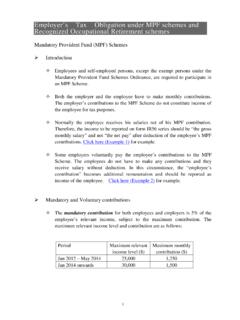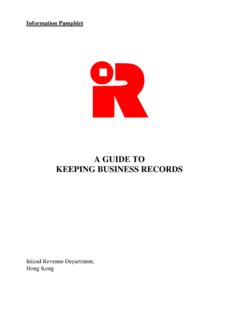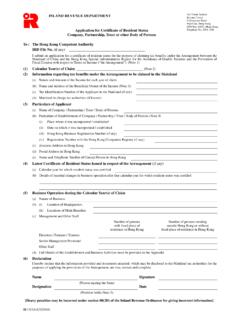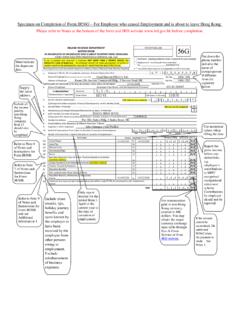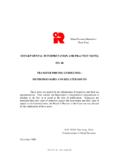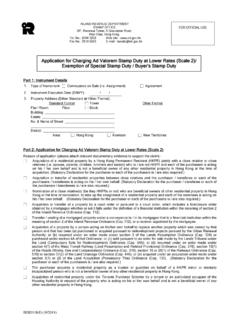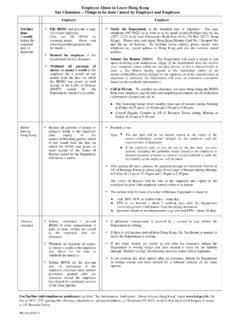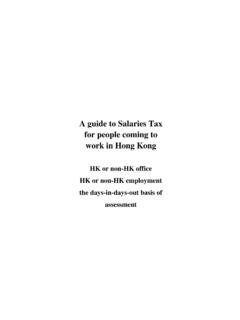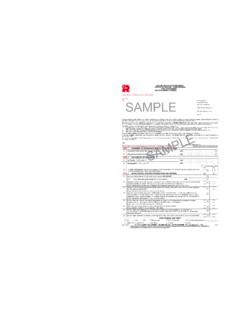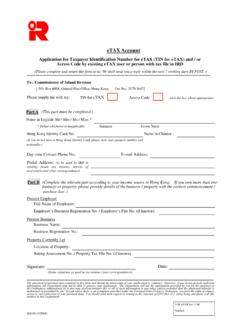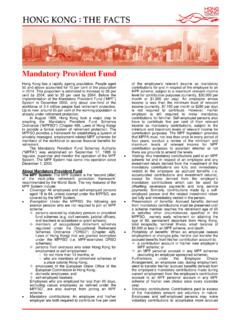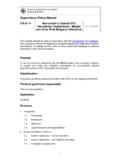Transcription of Deductibility of contributions for employees and self ...
1 Deductibility of contributions for employees and self-employed persons Mandatory Provident Fund Scheme or Recognized occupational retirement Scheme 1 Mandatory Provident Fund Scheme (MPFS) employees (full-time or part-time) and self-employed persons, except the exempt persons under the Mandatory Provident Fund schemes Ordinance ( MPFSO ) are required to participate in MPFS. employees or self-employed persons are required to make regular mandatory contribution calculated at 5% of the person s income, subject to the minimum and maximum relevant income level. The minimum and maximum relevant income level are as follows: Period Minimum income level ($) Nov 2013 onwards 7,100 Period Maximum relevant income level ($) Maximum monthly contribution ($) Jun 2012 May 2014 25,000 1,250 Jun 2014 onwards 30,000 1,500 Under the provisions of the Inland Revenue Ordinance ( IRO ), mandatory contributions to MPFS are deductible in computing the assessable income/profits of an employee or a self-employed person.
2 The maximum deduction for each year of assessment is : Year of assessment Maximum deduction ($) 2014/15 17,500 2015/16 onwards 18,000 2 employees The following examples explain the tax treatment for employees in various situations. Example 1 Single income source tax treatments in general The table below gives common scenarios for employees with a single source of income for the year of assessment 2019/ 20. Monthly Income Mandatory contributions (per year) Voluntary contributions (per year) Allowable Deductions $10,000 $6,000 - $6,000 $10,000 $6,000 $3,000 $6,000 $20,000 $12,000 - $12,000 $30,000 $18,000 - $18,000 Example 2 Fluctuating income An employee received a total income of $500,000 during year of assessment 2019/20. His income fluctuated over the year and he was exempt from the MPF scheme for April to June 2019 when his earnings fell below $5,000.
3 For the remaining 9 months he made mandatory contributions of $1,500 per month. A deduction of $13,500 will be allowed in computing his assessable income for the year. Example 3 Two employments and two MPF schemes An employee worked for Company A and Company B and received monthly salaries of $30,000 and $20,000 respectively. During the year of assessment 2019/20, he made mandatory contributions to each of his employers MPF schemes . Although the total mandatory contributions during the year were $30,000, the maximum amount deductible under salaries tax is $18,000 only. 3 Example 4 Two employments and one MPF scheme An employee received annual salaries of $180,000 from his principal employment. During the year of assessment 2019/ 20, he made mandatory contributions of $9,000 and voluntary contributions of $6,000 to a MPF scheme during the year.
4 He also received $3,500 per month ($42,000 for the year) from a part-time employment and was exempt from participating in the MPF scheme of his part-time employer. His net assessable income will be $222,000 (income from the two employments) less the mandatory contributions of $9,000. Example 5 Director s remuneration An executive director receiving a salary under a contract of employment is required to join a MPF scheme and is entitled to claim tax deduction for his mandatory contributions . The deduction shall not exceed the maximum deductible amount for the relevant year. A director who receives director s fees as an office holder is not an employee and is not required to participate in MPF scheme. Self-employed persons The following examples explain the tax treatment for various types of self-employed persons.
5 Example 6 Single business owners A sole proprietor of a business earned profits of $1,000,000 in a year of assessment. During the year of assessment 2019/ 20, he made mandatory contributions of $18,000 to a MPF scheme as a self-employed person. In computing the assessable profits of the business, a deduction of $18,000 will be allowed. If you are a self-employed person you can make a declaration of income to the trustee of the MPF scheme to determine the amount of mandatory contributions without obtaining a tax assessment from the Inland Revenue Department (IRD). 4 Example 7 Owners of multiple businesses A person operated 3 businesses as a sole proprietor and held interests in 3 partnerships. The aggregate income (including profits and losses) of all these businesses for the year of assessment 2019/ 20 was $500,000.
6 Under the MPF Ordinance, his mandatory contribution to a MPF scheme should be $18,000 for year of assessment 2019/ 20. The allowable deduction under profits tax will be $18,000. Example 8 Proprietor s spouse as employee A proprietor made mandatory contributions of $18,000 in the year of assessment 2019/20 as a self-employed person. His wife assisted him in running the business and joined the MPF scheme. Her contribution during the same year was $10,000. As the IRO does not permit the spouse of a proprietor to claim a deduction for MPF contributions , only the mandatory contributions of $18,000 made by the proprietor will be allowed as a deduction in calculating the assessable profits of the business. Example 9 Both employed and self-employed A person received salary income and operated a business at the same time.
7 He made mandatory contributions of over $18,000 to a MPF scheme as an employee and a self-employed person in the year of assessment 2019/20. However, the aggregate deductions under the salaries tax and profits tax will be $18,000 only. The following table explains this situation: Income Mandatory contributions Allowable Deductions Salaries $120,000 $6,000 $6,000 Profits $100,000 $5,000 $5,000 (Proprietorship) Salaries $500,000 $18,000 $18,000 Profits $400,000 $18,000 Nil (Proprietorship) Salaries $120,000 $6,000 $6,000 Profits $500,000 $18,000 $12,000 (Proprietorship) 5 Recognized occupational retirement schemes (RORS) If you opt to participate in a MPF-exempted ROR scheme, contributions you make to that scheme are also deductible, subject to the following restrictions: the amount deductible is the lesser of two amounts, that is, the amount you actually contributed to the ROR scheme or the amount of mandatory contribution that you would have been required to pay had that scheme been an MPF scheme.
8 And the maximum deduction for each year of assessment i s : Year of assessment Maximum deduction ($) 2014/15 17,500 2015/16 onwards 18,000 Example 10 Single income source An employee received annual remuneration of $180,000 during the year of assessment 2019/20. He opted to participate in the MPF-exempted ROR scheme operated by his employer. The contributions deductible for salaries tax in two scenarios are as follows: contributions to ROR Scheme Mandatory C ontributions to MPF Scheme Allowable Deductions $18,000 $9,000 $9,000 $5,400 $9,000 $5,400 Example 11 MPF and ROR schemes contributions An employee received annual remuneration of $120,000. He made contributions of $6,000 to a MPF scheme and $5,000 to a MPF-exempted ROR scheme at the same time. The allowable deduction will be $6,000, the amount contributed to the MPF scheme.
9 6 Keeping Proper Records To ensure that correct deductions are made for tax purposes, taxpayers should keep all proper records in respect of their contributions to MPFS and MPF-exempted RORS. These records should include the computations of their accrued benefits in the schemes , annual benefit statements and, where a transfer to another MPFS has taken place, the relevant transfer statements. They should be presented to the Inland Revenue Department for inspection if required. Further Information and Assistance You may (a) visit our website at ; or (b) telephone 187 8022. PAM 38(e) (The contents of this leaflet are for guidance only) April 2020
